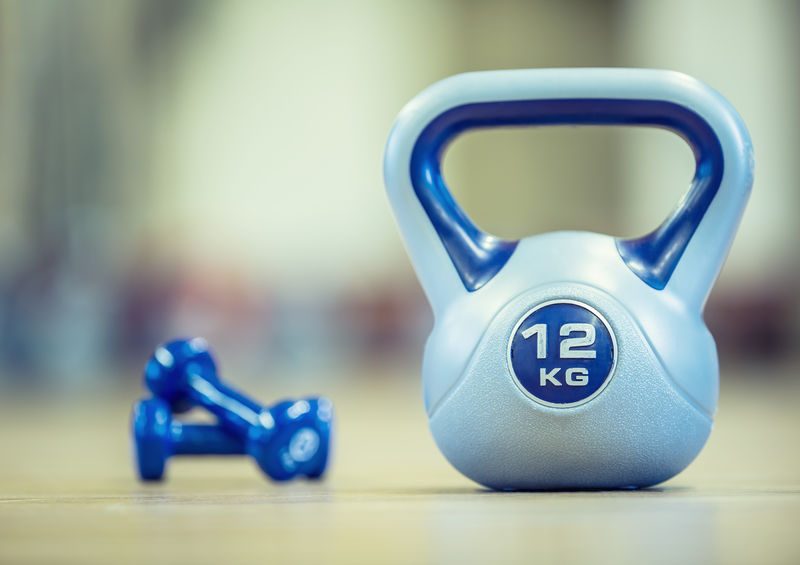
Sometimes kettlebells are the most appropriate personal training tool and other times dumbbells are needed to meet a client’s goals. Considering the desired outcome and the client are both keys to answering the question, “Which is more effective, kettlebells or dumbbells?”
During my typical week at the gym, I find myself making good use of both kettlebells and dumbbells with my clients. The instability component exists with both modalities, forcing the body to recruit more muscles than training on a weight machine.
However, given that the weight associated with a kettlebell is not balanced like a dumbbell, the body must work harder to stabilize and adapt to the changing center of gravity.
“The key to unlocking the power of the kettlebell is to use it differently than you would traditional weights,” explains Jason Brown, CSCS, owner of Kettlebell Athletics in Philadelphia.
History of the Kettlebell
Most fitness facilities offer kettlebells ranging in weight from 9 to 18 pounds, whereas dumbbells can be found ranging from1 to 12 pounds for lighter work and upwards of 110 pounds to satisfy the more serious lifters.
Interestingly, history plays a big part in clarifying this disparity. Kettlebells originated in Russia, with a unit of mass called a “pood” (16.38 kilograms or 36.11 pounds). While this unit of weight is considered antiquated and no longer utilized in mainstream gyms, it is still significant in the sport of “girevoy” which uses kettlebells.
Despite their apparent rise in popularity, kettlebells are not yet a huge commodity in this country’s fitness industry, and one of the few – if not the only one – holding on to the metric standard. However, keeping with the kilogram measurement ensures global consistency.
Weighing the Personal Training Client’s Goals
Listening to a client’s goals helps a trainer choose not only the exercises but the modality of execution as well. Dumbbells enable one to lift more weight with a controlled movement, facilitating the building of lean muscle mass and hence bigger muscles.
Kettlebells will indeed still build strength; however, fluidity of the common kettlebell exercise movements makes it much more challenging to zero in on a single muscle group. Such training tends to create more definition and less bulk.
Likewise, if weight loss /fat burning and building endurance are a client’s primary focus, kettlebells offer a multitude of ways to combine cardiovascular exercise with resistance training, even more so than dumbbell use.
When Kettlebells Are Better
When it comes to explosive, physical movements, kettlebells are most likely the optimal choice. If your client is interested in powerlifting, plyometric improvements, or competing in sports such as basketball or CrossFit games, research indicates that kettlebell use will lead to greater gains.
As compared to a dumbbell, the thicker horn (handle) found on a kettlebell makes it an ideal tool for increasing grip strength, says Liz Barnet, Certified Trainer at Uplift Studios in New York City. “For instance, a bent-over row with a kettlebell can strengthen the grip and help prepare you for challenging exercises like pull-ups.”
When Dumbbells Are Better
If a client’s goal is general strength and fitness, traditional dumbbell workouts are a perfect tool.“Dumbbells are great for a little bit of everything,” says Nikki Reifschneider, Assistant Director of Fitness and Personal Training at the University of Miami.
“You can start with more basic movements like a chest press, shoulder press, a row, or squat with dumbbells held at the shoulders… The advantage is that you’re not swinging the weight around (like you do in a snatch), making the moves a bit more straightforward”, Reifschneider says.
One study showed that, compared to dynamic moves with kettlebells, basic weightlifting exercises performed with traditional weights, such as power cleans and squats, may lead to significantly greater improvements in strength over a six-week period.
Designing Unique Programs
Since the typical client session lasts for 50-55 minutes, trainers need to be prudent in the exercises they choose when writing workouts. A typical total body kettlebell workout might include the following:
- Kettlebell Swings – a hip-driven movement where the explosive power comes from activating the hamstrings, back, and posterior chain of muscles, thereby improving speed, flexibility, and core strength.
- Single-Arm Kettlebell Press – make sure your eyes follow the weight throughout the movement. The benefit to doing an overhead press with a kettlebell is that it safeguards the shoulder slightly better than a dumbbell.
- Single-Arm Kettlebell Clean – the key is keeping your arm tucked in tightly, elbow by your side.
- Turkish Get-Up – a good exercise for your core.
- Bottoms Up Kettlebell Walks – keep your thumb near your shoulder or fully extend your arm, holding the weight over your head; maintain neutral spine/stable posture.
In contrast, a total body dumbbell workout might include these moves:
- Dumbbell Squats
- Chest Press
- Dumbbell Lateral Lunge – in addition to forward and reverse, incorporate lateral lunges to hit the glutes.
- Supported Single-Arm Row – one hand on your knee and hinging forward, keeping spine straight throughout the movement.
- Extended Sit-Up – executed from a lying position with knees bent; sit up to a tall spine, achieving a straight torso, arms overhead, dumbbells over shoulders, and biceps to ears.
Kettlebells or Dumbbells or Both?
Be creative as you incorporate both modalities in clients’ programs. By letting the goal be your roadmap, consider which exercises and which equipment will enable your client to achieve his goals in the most expedient fashion.
References
1.https://dailyburn.com/life/fitness/kettlebells-dumbbells-kettlebell-workout/
2.https://greatist.com/move/kettlebells-versus-dumbbells
3.https://www.livestrong.com/article/40561-kettlebells-vs.-dumbbells/
4.https://www.menshealth.com/fitness/a19534489/kettlebells-vs-free-weights-the-smackdown/
5.https://www.onnit.com/academy/5-unsung-differences-between-kettlebells-and-dumbbells/






